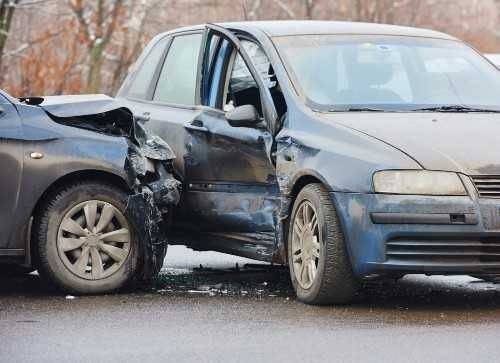Weather conditions can have a significant impact on the way car accidents occur and how they are handled in the context of legal claims. Drivers are always expected to operate their vehicles in a safe manner, but when adverse weather is introduced, the level of responsibility rises. Rain, snow, ice, fog, and even strong winds can create dangerous driving conditions, making it difficult to control a vehicle, see clearly, or maintain safe speeds. When these conditions contribute to a crash, determining liability and pursuing a fair claim can become complicated. Understanding the relationship between weather and car accident claims is important for those involved in accidents caused by these factors, as it can influence the legal process and the compensation one may be entitled to receive. Hepworth Holzer, LLP provides dedicated legal support and guidance to help clients navigate the complexities of car accident cases and pursue fair compensation.
The Impact of Rain on Car Accidents
Rain is one of the most common weather conditions that can lead to car accidents. Wet roads are slippery, making it difficult for drivers to maintain control of their vehicles, especially when turning or braking. Hydroplaning, which occurs when a vehicle’s tires lose contact with the road and glide over a layer of water, can also happen in heavy rain. This results in a complete loss of control, increasing the chances of a collision. In addition to the road surface becoming more hazardous, rain reduces visibility, making it harder for drivers to see other vehicles, pedestrians, or obstacles in their path.
When rain plays a role in a car accident, determining liability can be challenging. Insurance companies and legal representatives must assess whether the driver involved was taking appropriate precautions, such as reducing speed, using headlights, or avoiding sudden maneuvers. If a driver fails to adjust their driving habits to the weather, they may be found liable for the accident. However, if the weather conditions were extremely severe and the accident was unavoidable, the issue of liability becomes more complex. In such cases, a thorough investigation will be needed to determine fault and responsibility.
Snow and Ice
Snow and ice are notorious for causing dangerous road conditions. When snow covers the ground, it can obscure road markings and create slick surfaces, making it difficult for drivers to maintain control. Ice, particularly black ice, which is nearly invisible, poses an even greater risk. Vehicles that encounter icy patches can easily lose traction, leading to spinouts, skidding, or collisions with other cars, guardrails, or stationary objects.
In car accident claims involving snow and ice, the key question often revolves around whether the driver was exercising proper caution. Drivers are generally expected to reduce their speed, increase their following distance, and avoid sudden braking or accelerating in snowy or icy conditions. Failing to take these precautions can result in a driver being found liable for the accident. However, weather conditions may sometimes be so severe that even the most careful drivers find it impossible to avoid a crash. In such cases, determining liability may require testimony or accident reconstruction to assess the extent to which weather versus driver error played a role.
Insurance companies may also consider whether the city or municipality responsible for maintaining the roads took appropriate measures to ensure safety. If the roads were not adequately cleared or salted, and this contributed to the accident, the municipality could potentially share some of the liability. This introduces an additional layer of complexity to car accident claims in snowy or icy conditions.
Fog and Its Impact on Visibility
Fog is another weather condition that can dramatically affect driving safety. Dense fog reduces visibility to the point where drivers may be unable to see other vehicles, traffic signals, or road signs until it is too late. This lack of visibility can cause rear-end collisions, side swipes, and even multi-car pileups. Fog also affects depth perception and the ability to judge the speed and distance of other vehicles, making it even more dangerous for drivers who are not accustomed to such conditions.
When fog is a factor in a car accident, legal claims often hinge on whether drivers were operating their vehicles in a manner appropriate for the conditions. Drivers are expected to slow down, use their headlights, and maintain a safe distance from the vehicle in front of them when visibility is reduced. If a driver fails to take these precautions and causes an accident, they may be found liable. However, the dense fog itself can complicate the situation, as even the most cautious drivers can find themselves involved in accidents due to the sudden appearance of obstacles or other vehicles.
In these cases, an investigation may look into the specific driving behaviors and road conditions at the time of the accident. Weather reports, witness statements, and possibly even video footage may be examined to determine how much of a role the fog played and whether the driver could have reasonably avoided the crash.
High Winds and Vehicle Control
High winds are another weather condition that can make driving dangerous. Strong winds can cause vehicles to swerve, particularly high-profile vehicles like trucks or SUVs. Winds can also blow debris onto the road, creating additional hazards for drivers. In extreme cases, high winds can make it difficult to keep a vehicle in its lane, leading to sideswipes, collisions, or accidents involving stationary objects like guardrails or trees.
When high winds contribute to a car accident, determining liability can be a complex process. As with other weather-related accidents, the key question will be whether the driver was taking appropriate precautions for the conditions. For example, drivers are expected to reduce their speed and maintain a firm grip on the steering wheel in high wind situations. If a driver is speeding or otherwise driving recklessly in such conditions, they may be found liable for the accident.
However, if the winds were particularly strong and sudden, it may be argued that the accident was unavoidable. As with other weather-related accidents, a detailed investigation will be needed to assess how much of a role the weather played and whether the driver could have reasonably prevented the crash.
Legal Considerations in Weather-Related Car Accidents
Weather-related car accidents often require a deeper investigation compared to other types of accidents. Insurance companies, legal teams, and sometimes accident reconstruction specialists will need to evaluate the specific weather conditions at the time of the crash and how those conditions influenced the actions of the drivers involved. Determining fault can be difficult because the weather itself may be viewed as a contributing factor, but not necessarily the sole cause of the accident.
In Idaho, as in many other states, drivers are required to exercise what is known as “reasonable care” based on the circumstances they are facing. This means that drivers must adjust their behavior according to the weather conditions. If a driver fails to adjust and causes an accident, they can be found negligent, even if the weather played a role. However, proving negligence in weather-related accidents can be challenging, as it involves showing that the driver did not take the appropriate precautions that a reasonable person would have taken under the same circumstances.
In some cases, multiple parties may share liability in a weather-related car accident. For example, if a road was not properly maintained or cleared of snow and ice, a municipality or state agency responsible for maintaining the road may be partially liable. Additionally, if the accident involved multiple vehicles, determining fault may involve untangling a complex web of interactions between the drivers, the weather, and the road conditions.
Gathering Evidence for a Weather-Related Car Accident Claim
When pursuing a car accident claim that involves weather conditions, gathering the right evidence is crucial. Documentation of the weather conditions at the time of the accident can help establish whether the driver acted reasonably given the circumstances. Weather reports, photographs of the accident scene, and witness statements can all play a vital role in determining how the weather contributed to the crash and whether the drivers involved were exercising proper caution.
It is also important to document any damage to the vehicle and any injuries sustained in the accident. Medical records, repair estimates, and police reports will all be essential pieces of evidence in building a strong claim. In some cases, accident reconstruction specialists may be brought in to assess the road conditions and recreate the events leading up to the crash, providing a more detailed picture of how the weather affected the situation.
How to Handle Insurance Claims After a Car Accident in Idaho
Getting involved in a car accident can be a traumatic and overwhelming experience. Not only do you have to deal with any injuries and property damage, but you also need to navigate the insurance claims process. Understanding how to handle insurance claims after a car accident is crucial in order to protect your rights and receive the compensation you deserve. In the state of Idaho, specific requirements and guidelines govern the insurance claim process, and being familiar with them can greatly assist you in pursuing a successful claim. In this article, we will explore the steps to take and the requirements to meet when handling insurance claims after a car accident in Idaho.
Seek Medical Attention:
The first and most important step after a car accident is to ensure the safety and well-being of all parties involved. If anyone is injured, seek immediate medical attention. Even if you don’t experience any immediate pain or symptoms, it is still recommended to undergo a medical evaluation as some injuries may have delayed onset symptoms.
Report the Accident:
After ensuring safety, report the accident to law enforcement. In Idaho, it is mandatory to report any accident that involves injury, death, or property damage exceeding $1,500. Contact the local police or the Idaho State Police and provide them with accurate information about the accident. It’s crucial to obtain a copy of the accident report, as it will serve as essential documentation for your insurance claim.
Notify Your Insurance Company:
Promptly notify your insurance company about the accident, regardless of who is at fault. Most insurance policies have a requirement to report accidents in a timely manner. Provide them with accurate details and facts regarding the accident, but avoid admitting fault or making speculative statements. Be prepared to share information about the other parties involved, the extent of damages, and any injuries sustained.
Gather Evidence:
Collecting evidence is crucial for supporting your insurance claim. Take photographs of the accident scene, vehicle damage, and any visible injuries. Obtain contact information from all parties involved, including witnesses. Additionally, note down any relevant details, such as road conditions, weather, and the time of day. These pieces of evidence will help strengthen your claim and provide a clear picture of the accident.
Follow Idaho’s Fault System:
Idaho follows a fault-based system when it comes to car accidents and insurance claims. This means that the party at fault for the accident is responsible for the resulting damages. However, Idaho also allows for comparative negligence, where the damages awarded are proportionally reduced based on the degree of fault assigned to each party. Understanding this system is essential in determining how liability will be allocated and how it might affect your claim.
Cooperate with the Insurance Adjuster:
After filing your claim, an insurance adjuster will be assigned to assess the damages and investigate the accident. It is important to cooperate with them while also being cautious. Remember that insurance adjusters work for the insurance company and may try to minimize your claim. Stick to the facts, provide only necessary information, and consult with an attorney if you have any concerns or doubts about the process.
Consult with an Attorney:
While handling the insurance claim process on your own is possible, consulting with a knowledgeable attorney specializing in personal injury and car accident cases can greatly benefit your claim. An attorney can guide you through the complexities of the legal system, help negotiate with insurance companies, and ensure that your rights are protected. They can also assist in gathering evidence, assessing damages, and accurately valuing your claim.
Document Medical Expenses and Losses:
In order to receive proper compensation for your injuries and losses, it is essential to document all medical expenses and financial losses resulting from the car accident. Keep records of medical bills, prescription costs, therapy expenses, and any other healthcare-related expenditures. Additionally, keep track of any lost wages or income due to missed work as a result of the accident. These documents will help establish the extent of your damages and ensure that you are adequately compensated for your losses.
Be Cautious of Early Settlement Offers:
Insurance companies often try to settle claims quickly and for the lowest possible amount. Be cautious when presented with an early settlement offer. It may seem tempting to accept the offer, especially if you are facing financial difficulties after the accident. However, these initial offers are often far below the actual value of your claim. It is advisable to consult with an attorney before accepting any settlement to ensure that you are receiving fair compensation for your injuries and damages.
Prepare for Litigation, if Necessary:
While most car accident claims can be resolved through negotiation and settlement, there are instances where litigation becomes necessary. If you are unable to reach a fair settlement with the insurance company or if liability is being disputed, preparing for a lawsuit may be the next step. In such cases, having an experienced car accident attorney on your side is crucial. They will gather additional evidence, work with expert witnesses, and represent your best interests in court, maximizing your chances of a favorable outcome.
Maintain Communication and Stay Organized:
Throughout the entire claims process, it is important to maintain open communication with your insurance company, the other party involved, and your attorney, if you have one. Promptly respond to any requests for information and keep detailed records of all communication, including phone calls, emails, and letters. Staying organized will help ensure that you have a clear record of the progress of your claim and can address any issues or concerns that may arise.
Requirements for Insurance Claims in Idaho:
In Idaho, there are several requirements that must be met when filing an insurance claim after a car accident. These include:
Statute of Limitations: Idaho has a statute of limitations that sets a time limit for filing a personal injury or property damage claim. In Idaho, the statute of limitations for personal injury claims is two years from the date of the accident, and for property damage claims, it is three years. Failing to file a claim within the specified time period may result in the loss of your right to seek compensation.
Minimum Insurance Requirements: Idaho law mandates that all drivers carry minimum liability insurance coverage. The minimum requirements are $25,000 for bodily injury or death per person, $50,000 for bodily injury or death per accident, and $15,000 for property damage per accident. It is important to ensure that both you and the other party involved in the accident meet these minimum insurance requirements.
Comparative Negligence: Idaho follows the comparative negligence rule, which means that if you are found partially at fault for the accident, the compensation you receive will be reduced proportionally. For example, if you are found to be 20% at fault and the total damages are $10,000, your compensation will be reduced by 20% to $8,000.
Uninsured/Underinsured Motorist Coverage: Although not required by law, it is highly recommended to have uninsured/underinsured motorist (UM/UIM) coverage. This coverage protects you if the at-fault party does not have insurance or has insufficient coverage to compensate you adequately for your damages.
Navigating the insurance claims process after a car accident in Idaho can be complex and challenging. By following the steps outlined in this article and understanding the specific requirements in Idaho, you can increase your chances of receiving fair compensation for your injuries and property damage. If you need assistance with your insurance claim or have any legal concerns, don’t hesitate to contact Hepworth Holzer, LLP. Our experienced attorneys are dedicated to helping accident victims in Idaho navigate the legal system and obtain the justice they deserve. Contact us today for a free consultation.
Handling insurance claims after a car accident in Idaho requires a thorough understanding of the steps to take and the specific requirements of the state. Seeking medical attention, reporting the accident, notifying your insurance company, gathering evidence, and cooperating with the insurance adjuster are all important aspects of the process. Additionally, understanding Idaho’s fault system, consulting with an attorney, and meeting the state’s insurance claim requirements are crucial for ensuring a successful claim. By being well-informed and seeking professional guidance, you can protect your rights and maximize your chances of receiving fair compensation for your car accident injuries and damages.
The Statute of Limitations in Idaho
In Idaho, as well as in most states, there is a statute of limitations that governs the time frame within which you must file a car accident claim. The statute of limitations is essentially a legal time limit that dictates how long you have to initiate a lawsuit after an accident has occurred. The purpose of such limitations is to ensure that claims are filed in a timely manner, preserving the integrity of evidence and protecting the interests of both parties involved.
Time Limits for Personal Injury Claims
If you were injured in a car accident and wish to file a personal injury claim, it’s crucial to be aware of the statute of limitations. In Idaho, the statute of limitations for personal injury claims, which includes car accident-related injuries, is typically two years from the date of the accident. This means you have a two-year window from the accident date to file a lawsuit seeking compensation for your injuries.
Failing to file within this time frame could result in your claim being dismissed by the court, effectively barring you from seeking compensation for your injuries through a legal process. It’s important to note that the statute of limitations for personal injury claims applies to injuries sustained in the accident, not property damage claims.
Importance of Timely Action
Filing a car accident claim as soon as possible is highly recommended for several reasons. First, gathering evidence and witness statements is easier when the incident is still fresh in everyone’s minds. Delaying the claim could lead to the loss of critical evidence, making it challenging to build a strong case.
Second, insurance companies often require prompt notification of accidents and claims. Failing to report the accident in a timely manner could potentially lead to a denial of coverage or delayed processing of your claim.
Lastly, meeting the statute of limitations is essential for maintaining your legal right to seek compensation. Missing the deadline may result in the inability to pursue a lawsuit, leaving you without a means to recover damages.
Understanding Car Accident Claims for Rear-End Collisions in Idaho
Rear-end collisions are among the most common types of car accidents in Idaho and often result in significant property damage and personal injury. Understanding how to navigate the claims process for these incidents is crucial for ensuring you receive the compensation you deserve. The state of Idaho has specific laws and regulations that govern car accident claims, and being informed about these can make a substantial difference in the outcome of your case. At Hepworth Holzer, LLP, we are committed to guiding you through every step of the process, providing the support you need to secure a favorable resolution.
Rules of a Personal Injury Claim Choosing a Personal Injury AttorneyRelated Videos
Causes of Rear-End Collisions
Rear-end collisions can occur for a variety of reasons, many of which are preventable. Common causes include distracted driving, speeding, sudden stops, and following too closely. In many cases, the driver of the rear vehicle is found to be at fault due to failure to maintain a safe distance. However, there are situations where the leading vehicle may share some responsibility, such as abrupt and unexpected stops without adequate signaling. Understanding the cause of the accident is critical in determining liability and pursuing a claim.
Establishing Liability in Rear-End Collisions
In Idaho, the principle of negligence plays a central role in car accident claims. To establish liability, it must be proven that the at-fault driver failed to exercise reasonable care, resulting in the accident. In rear-end collisions, the presumption is often that the rear driver is at fault. However, this presumption can be challenged if there is evidence that the lead driver contributed to the incident. Gathering evidence such as witness statements, traffic camera footage, and accident reconstruction reports is essential in building a strong case.
The Claims Process in Idaho
The process of filing a car accident claim in Idaho begins with notifying your insurance company about the accident. It is important to provide accurate and detailed information, including the date, time, location, and a description of the events leading up to the collision. Your insurer will then assign an adjuster to investigate the claim and determine the extent of damages and liability. If the other driver is found to be at fault, their insurance company will be responsible for covering the damages.
Medical Treatment and Documentation
Receiving prompt medical treatment after a rear-end collision is crucial, even if you do not feel immediate pain or discomfort. Injuries such as whiplash, concussions, and soft tissue damage may not present symptoms right away but can have long-term effects if left untreated. Documentation of your injuries and medical treatment is vital in supporting your claim. Ensure that all medical visits, treatments, and prescriptions are thoroughly recorded and that you follow through with any recommended treatment plans.
Calculating Damages
Damages in a car accident claim can be categorized into economic and non-economic damages. Economic damages include medical expenses, lost wages, and property damage. Non-economic damages refer to pain and suffering, emotional distress, and loss of enjoyment of life. In Idaho, there are no caps on economic damages, but non-economic damages may be subject to certain limitations. Accurately calculating these damages requires a comprehensive understanding of your losses and future needs, often necessitating professional assessments and documentation.
Filing a Lawsuit
If a fair settlement cannot be reached through negotiations, you may need to file a lawsuit to pursue the compensation you deserve. The statute of limitations for car accident claims in Idaho is two years from the date of the accident. Failing to file within this timeframe can result in the loss of your right to seek compensation. The litigation process involves several stages, including the filing of a complaint, discovery, and potentially a trial. Throughout this process, having an experienced attorney by your side can ensure that your case is presented effectively and that your rights are protected.
The Role of Comparative Fault
Idaho follows the doctrine of comparative fault, which means that fault can be divided among multiple parties based on their level of responsibility for the accident. If you are found to be partially at fault, your compensation may be reduced by your percentage of fault. For example, if you are found to be 20% at fault, your compensation will be reduced by 20%. Understanding how comparative fault works and presenting a strong case to minimize your liability is crucial in maximizing your compensation.
Importance of Legal Representation
Navigating the complexities of a car accident claim can be challenging, especially when dealing with insurance companies and legal procedures. Having legal representation ensures that your case is handled professionally and that your rights are upheld throughout the process. An attorney can assist with gathering evidence, calculating damages, negotiating with insurers, and representing you in court if necessary. At Hepworth Holzer, LLP, we have extensive experience in handling car accident claims and are dedicated to achieving the best possible outcome for our clients.
What to Do Immediately After a Rear-End Collision
Taking the right steps immediately after a rear-end collision can significantly impact the success of your claim. First and foremost, ensure that everyone involved is safe and seek medical attention if necessary. Contact the police to report the accident and obtain a copy of the police report. Gather information from the other driver, including their name, contact details, insurance information, and vehicle registration. Take photographs of the accident scene, vehicle damage, and any visible injuries. Collect contact information from any witnesses and avoid making statements that could be interpreted as admitting fault.
Common Injuries in Rear-End Collisions
Rear-end collisions can result in a range of injuries, from minor to severe. Whiplash is one of the most common injuries, caused by the sudden jerking motion of the head and neck. Other common injuries include concussions, spinal injuries, fractures, and soft tissue damage. The severity of these injuries can vary, and some may require long-term medical treatment and rehabilitation. Documenting your injuries and following through with medical treatment is essential in supporting your claim and ensuring you receive appropriate compensation for your suffering and losses.
Dealing with Uninsured or Underinsured Drivers
In some cases, the at-fault driver may be uninsured or underinsured, complicating the claims process. If you have uninsured/underinsured motorist coverage as part of your insurance policy, you may be able to file a claim with your own insurance company to cover your damages. This type of coverage is designed to protect you in situations where the at-fault driver cannot fully compensate you for your losses. Understanding your policy and the options available to you is important in ensuring you receive the compensation you need.
The Impact of Rear-End Collisions on Your Life
A rear-end collision can have far-reaching effects on your life, impacting your physical health, emotional well-being, and financial stability. Physical injuries may require ongoing medical treatment and rehabilitation, while emotional distress can affect your mental health and quality of life. Additionally, lost wages and medical expenses can create financial strain. Pursuing a claim is not just about compensation for immediate losses but also about securing your future and ensuring you can recover fully from the impact of the accident.
If you have been involved in a car accident in Idaho, navigating the legal complexities of your claim can be overwhelming. The team at Hepworth Holzer, LLP understands the challenges of car accident claims and can help you build a strong case to pursue the compensation you deserve. With experienced legal representation on your side, you can focus on recovering from your injuries while we handle the intricacies of your claim. Contact Hepworth Holzer, LLP today to discuss your case and take the first step towards securing the compensation you need.
Verdicts & Settlements










